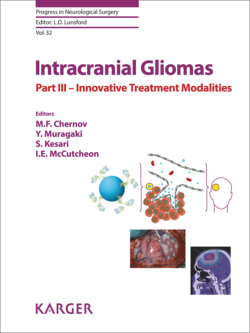Читать книгу Intracranial Gliomas Part III - Innovative Treatment Modalities - Группа авторов - Страница 52
На сайте Литреса книга снята с продажи.
Perioperative Complications
ОглавлениеPerioperative complications encountered in the present series are summarized in the Table 1. One patient died owed to intracerebral hemorrhage after stereotactic tumor biopsy and cryodestruction.
Surgical complications included intracerebral hematoma (4 cases), prominent brain edema (2 cases), and infection (4 cases). Two patients with intracerebral hematoma and one patient with prominent brain edema underwent urgent life-saving craniotomy directed at evacuation of the blood clot and necrotic neoplastic tissue, respectively. Of note, both patients with severe postoperative brain edema were treated early in the series and had a volume of cryoablation as large as 30 cm3, which was avoided later on with added clinical experience. One patient had a cerebral abscess, which was treated with stereotactic puncture and needle aspiration. Therefore, additional surgical procedures for management of complications were required in 4 cases (4.5%) of the present series.
New or prominent aggravation of the pre-existing neurological deficit after surgery was noted in 37 patients. Hemiparesis was marked in 30 cases, but usually resolved with time at least up to preoperative level. Deterioration of speech function was observed in 5 patients with tumors within the dominant insula (2 cases), frontal lobe (2 cases), and temporal lobe (1 case); 3 cases of motor aphasia resolved completely, but in 2 patients with sensory aphasia only partial recovery was attained. In one patient with AA of the dominant frontal lobe both motor aphasia and severe hemiparesis had developed after surgery; speech function restored completely, whereas mild motor deficit was presented at 2 months follow-up. Overall, permanent deterioration of neurological function was noted in 7 patients (8%) of the present series.
Observed rates of postoperative mortality (1.1%) and surgical complications (11.4%) after stereotactic cryodestruction of supratentorial gliomas well correspond to reported results of stereotactic biopsy of brain tumors [35], whereas the rate of neurological morbidity (42%) is comparable to outcome after resection of tumors within eloquent brain areas. Of note, microsurgical removal of insular and opercular gliomas is accompanied by neurological deterioration during the early postoperative period in 59–82% of patients, and in 6–6.5% of cases the deficit persists even after intensive neurorehabilitation [36–38].
